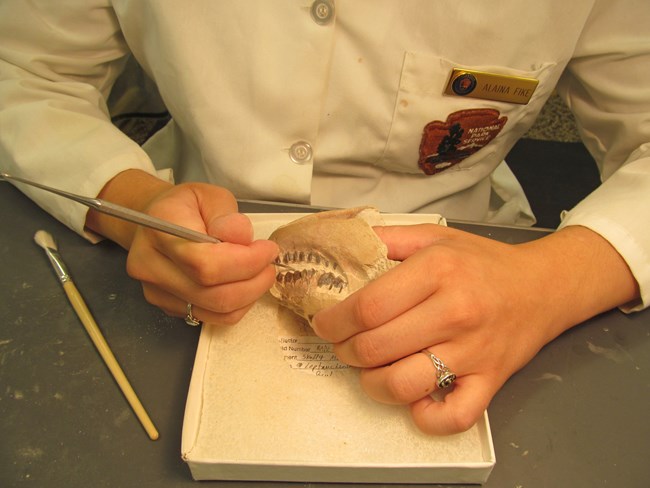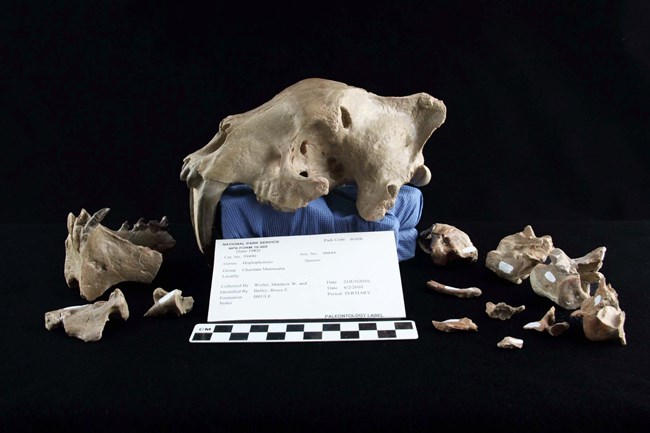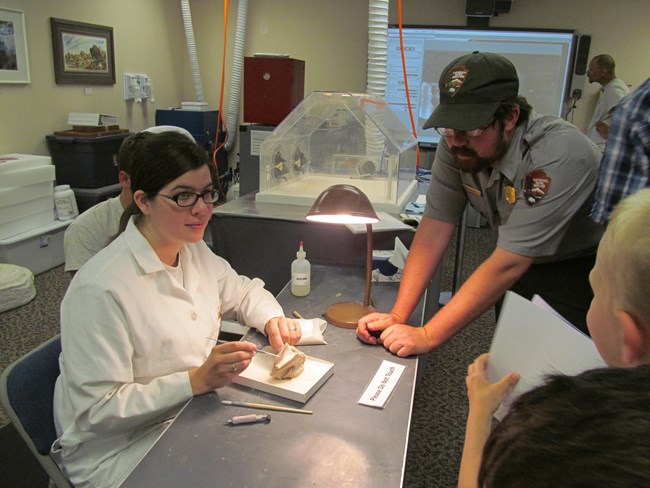Part of a series of articles titled Badlands Geology and Paleontology.
Article
Paleontology in the White River Badlands

NPS Photo / Larry McAfee
What is Paleontology?
Paleontology is the study of ancient life. In Badlands National Park, most fossils are from vertebrates, ancient animals with backbones. The scientists who research these backboned creatures are called vertebrate paleontologists.
Fossils are the primary tools used by paleontologists to puzzle out the mysteries of past ecosystems and the animals that lived within them. A fossil is any evidence of past life that has been preserved. Bones and teeth typically come to mind when we think of fossilized remains. However, the imprints of leaves, seeds, wood, shells, eggs, feathers, footprints, and burrows can also become fossilized under special circumstances. Even ancient feces can become a fossil and provide clues to ancient diets. Fossils are the meeting place between geology and biology – life turned to stone.

NPS Photo
Fossil Roots Run Deep
Long before paleontology existed as a formal discipline, the people of the Oglala Lakota Nation discovered large fossilized bones and turtle shells. They also found fossilized seashells and were the first to realize this area had once been underwater. European interest in the area started with the trappers and traders who explored the area, travelling from Fort Pierre in the Dakota Territory to Fort Laramie in Wyoming during the 1830s.
The White River Badlands are located primarily in South Dakota but extend through northwest Nebraska into eastern Wyoming. Badlands National Park is an exceptional example of the larger exposures of the White River Badlands. Scientists have studied specimens from this region since the 1840s, just after “dinosaur” became a new word. The area now included in Badlands National Park is considered to be the birthplace of vertebrate paleontology in the American West. The first Badlands specimens are now a part of the National Museum of Natural History at the Smithsonian Institution in Washington, D.C.
By the mid-1800s, 84 distinct species of animals had been identified in the North American fossil record – 77 of which were found in the White River Badlands. Institutions such as Yale University and the American Academy of Sciences began sending regular trips to the region to collect fossils for reassembly in the first great museums on the East Coast. The longest continuous relationship between the Badlands and academia is the century-long exploration of the area by the South Dakota School of Mines and Technology.

NPS Photo / Larry McAfee
A Passionate Profession
Studying fossils tends to be an all-consuming passion for those who have the commitment. Although not all fossil fans choose to make their living from academic pursuits, it is an interest that makes amateurs and professionals alike feel compelled to explore and learn more. Keep in mind that fieldwork is only the beginning of a paleontologist’s work. For every hour of fieldwork done, there will likely be at least twelve hours of preparation completed in a laboratory. This preparation allows for a deeper understanding of the fossil and helps contextualize it. The study of fossils helps us understand the history of life and how different types of animals respond to changes in environment and climate. In these days of global warming, the key to human survival could be locked in the fossil past.
Some think, “If there are so many fossils, it won’t hurt if I take just one.” Has this thought ever crossed your mind? It is a common response but one that has a destructive – and illegal – result. When you find a fossil, you are taking a peek into the past. It is likely that you are the first human being to ever see that specimen. There is a good chance that any new fossil discovery could provide new information on the Badlands story. National Parks belong to everyone, so leave any fossil you may find in place so that others may enjoy the same sense of discovery. Also, feel free to report any fossil discoveries to park staff and turn in a Visitor Site Report.
Last updated: November 10, 2020
